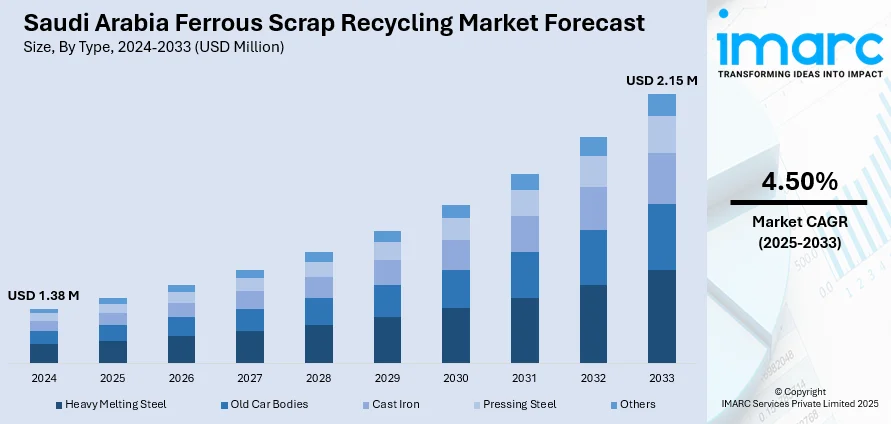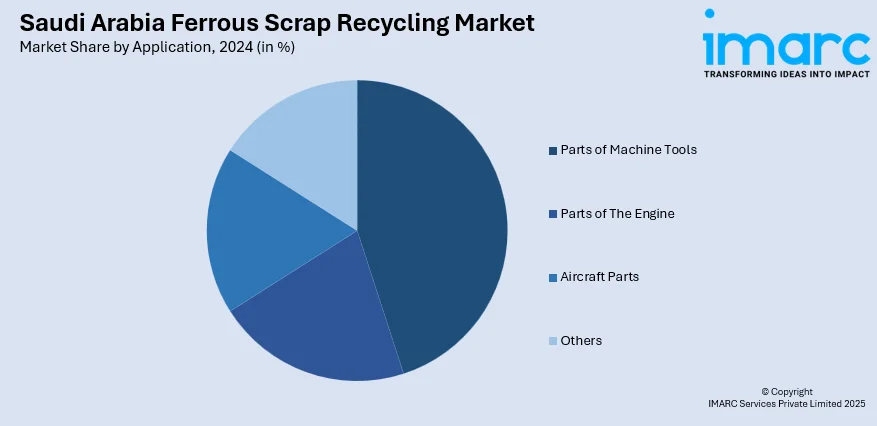
Saudi Arabia Ferrous Scrap Recycling Market Size, Share, Trends and Forecast by Type, Application, End User, and Region, 2025-2033
Saudi Arabia Ferrous Scrap Recycling Market Overview:
The Saudi Arabia ferrous scrap recycling market size reached USD 1.38 Million in 2024. Looking forward, IMARC Group expects the market to reach USD 2.15 Million by 2033, exhibiting a growth rate (CAGR) of 4.50% during 2025-2033. The market is driven by the increased demand for steel in the construction, automotive, and infrastructure industries. Moreover, government policies favoring circular economy practices, along with Vision 2030 emphasis on sustainable industrial development, are increasingly propelling recycling operations. Furthermore, technology advancements in metal recovery and a rise in environmental regulation awareness are further augmenting the Saudi Arabia ferrous scrap recycling market share.
|
Report Attribute
|
Key Statistics
|
|---|---|
|
Base Year
|
2024
|
|
Forecast Years
|
2025-2033
|
|
Historical Years
|
2019-2024
|
| Market Size in 2024 | USD 1.38 Million |
| Market Forecast in 2033 | USD 2.15 Million |
| Market Growth Rate 2025-2033 | 4.50% |
Saudi Arabia Ferrous Scrap Recycling Market Trends:
Expansion of Domestic Steel Manufacturing and Infrastructure Projects
The ongoing investments in steel-intensive infrastructure projects has significantly increased domestic demand for ferrous scrap, driving growth in the recycling sector. Notably, the Minister of Economy and Planning announced that investments in the Kingdom’s infrastructure sector are expected to exceed USD 1 Trillion by 2030, backed by clear economic targets and long-term private-sector initiatives. Additionally, major initiatives under Vision 2030, including the NEOM smart city, the Red Sea Project, and large-scale urban development plans in Riyadh and Jeddah, require substantial volumes of steel, which encourages the usage of recycled scrap as a cost-effective raw material. Moreover, domestic steel producers are increasingly sourcing scrap locally to reduce reliance on imported iron ore, enhance supply chain resilience, and lower production costs. The establishment of electric arc furnace (EAF) facilities, which utilize ferrous scrap more efficiently, has further strengthened demand. EAF-based production aligns with environmental sustainability goals by reducing carbon emissions, making scrap recycling a strategic focus for steelmakers. The localization of scrap processing and melting operations, supported by government policies and investment incentives, continues to create a sustained Saudi Arabia ferrous scrap recycling market growth.

Strengthening Regulatory Environment and Environmental Compliance
Environmental legislation and regulatory reforms are increasingly shaping the market in Saudi Arabia. The Saudi Ministry of Environment, Water and Agriculture, along with the National Center for Waste Management (MWAN), has introduced stricter controls on waste management practices, including mandates for industrial waste segregation and recycling. Moreover, one of Vision 2030's primary objectives is to remove 82% of waste from landfills by 2035. This change aims to prevent environmental contamination caused by trash accumulation and focuses on protecting land resources. Ferrous scrap recycling directly contributes to these objectives by enabling the reuse of materials that would otherwise burden waste systems. Additionally, the Saudi Standards, Metrology, and Quality Organization (SASO) are implementing quality standards for recycled materials, encouraging professionalization and compliance among recyclers. Large industries, particularly those in construction, automotive dismantling, and manufacturing, are now required to adhere to proper scrap handling and disposal procedures, incentivizing partnerships with certified recycling firms. As enforcement mechanisms strengthen and environmental reporting becomes more standardized, recycling operations are becoming more structured, regulated, and transparent, creating a formalized ecosystem for ferrous scrap recovery.
Saudi Arabia Ferrous Scrap Recycling Market Segmentation:
IMARC Group provides an analysis of the key trends in each segment of the market, along with forecasts at the country and regional levels for 2025-2033. Our report has categorized the market based on type, application, and end user.
Type Insights:
- Heavy Melting Steel
- Old Car Bodies
- Cast Iron
- Pressing Steel
- Others
The report has provided a detailed breakup and analysis of the market based on the type. This includes heavy melting steel, old car bodies, cast iron, pressing steel, and others.
Application Insights:

- Parts of Machine Tools
- Parts of The Engine
- Aircraft Parts
- Others
A detailed breakup and analysis of the market based on the application have also been provided in the report. This includes parts of machine tools, parts of the engine, aircraft parts, and others.
End User Insights:
- Construction
- Automotive
- Shipbuilding
- Equipment Manufacturing
- Consumer Appliances
- Others
The report has provided a detailed breakup and analysis of the market based on the end user. This includes construction, automotive, shipbuilding, equipment manufacturing, consumer appliances, and others.
Regional Insights:
- Northern and Central Region
- Western Region
- Eastern Region
- Southern Region
The report has also provided a comprehensive analysis of all the major regional markets, which include Northern and Central Region, Western Region, Eastern Region, and Southern Region.
Competitive Landscape:
The market research report has also provided a comprehensive analysis of the competitive landscape. Competitive analysis such as market structure, key player positioning, top winning strategies, competitive dashboard, and company evaluation quadrant has been covered in the report. Also, detailed profiles of all major companies have been provided.
Saudi Arabia Ferrous Scrap Recycling Market Report Coverage:
| Report Features | Details |
|---|---|
| Base Year of the Analysis | 2024 |
| Historical Period | 2019-2024 |
| Forecast Period | 2025-2033 |
| Units | Million USD |
| Scope of the Report |
Exploration of Historical Trends and Market Outlook, Industry Catalysts and Challenges, Segment-Wise Historical and Future Market Assessment:
|
| Types Covered | Heavy Melting Steel, Old Car Bodies, Cast Iron, Pressing Steel, Others |
| Applications Covered | Parts of Machine Tools, Parts of The Engine, Aircraft Parts, Others |
| End Users Covered | Construction, Automotive, Shipbuilding, Equipment Manufacturing, Consumer Appliances, Others |
| Regions Covered | Northern and Central Region, Western Region, Eastern Region, Southern Region |
| Customization Scope | 10% Free Customization |
| Post-Sale Analyst Support | 10-12 Weeks |
| Delivery Format | PDF and Excel through Email (We can also provide the editable version of the report in PPT/Word format on special request) |
Key Questions Answered in This Report:
- How has the Saudi Arabia ferrous scrap recycling market performed so far and how will it perform in the coming years?
- What is the breakup of the Saudi Arabia ferrous scrap recycling market on the basis of type?
- What is the breakup of the Saudi Arabia ferrous scrap recycling market on the basis of application?
- What is the breakup of the Saudi Arabia ferrous scrap recycling market on the basis of end user?
- What is the breakup of the Saudi Arabia ferrous scrap recycling market on the basis of region?
- What are the various stages in the value chain of the Saudi Arabia ferrous scrap recycling market?
- What are the key driving factors and challenges in the Saudi Arabia ferrous scrap recycling market?
- What is the structure of the Saudi Arabia ferrous scrap recycling market and who are the key players?
- What is the degree of competition in the Saudi Arabia ferrous scrap recycling market?
Key Benefits for Stakeholders:
- IMARC’s industry report offers a comprehensive quantitative analysis of various market segments, historical and current market trends, market forecasts, and dynamics of the Saudi Arabia ferrous scrap recycling market from 2019-2033.
- The research report provides the latest information on the market drivers, challenges, and opportunities in the Saudi Arabia ferrous scrap recycling market.
- Porter's five forces analysis assist stakeholders in assessing the impact of new entrants, competitive rivalry, supplier power, buyer power, and the threat of substitution. It helps stakeholders to analyze the level of competition within the Saudi Arabia ferrous scrap recycling industry and its attractiveness.
- Competitive landscape allows stakeholders to understand their competitive environment and provides an insight into the current positions of key players in the market.
Need more help?
- Speak to our experienced analysts for insights on the current market scenarios.
- Include additional segments and countries to customize the report as per your requirement.
- Gain an unparalleled competitive advantage in your domain by understanding how to utilize the report and positively impacting your operations and revenue.
- For further assistance, please connect with our analysts.
 Request Customization
Request Customization
 Speak to an Analyst
Speak to an Analyst
 Request Brochure
Request Brochure
 Inquire Before Buying
Inquire Before Buying




.webp)




.webp)












